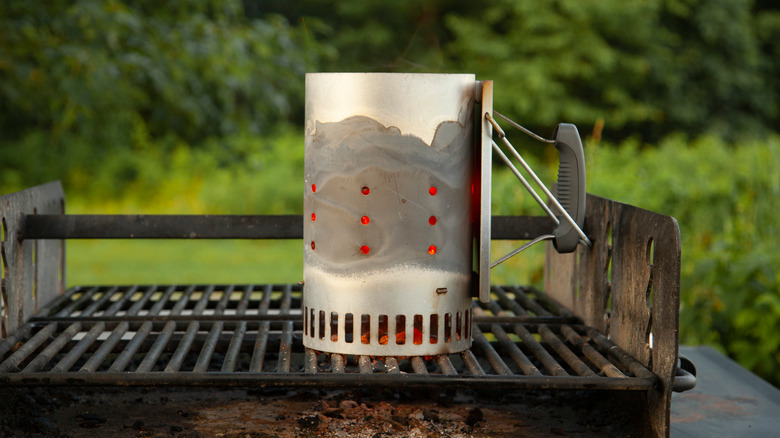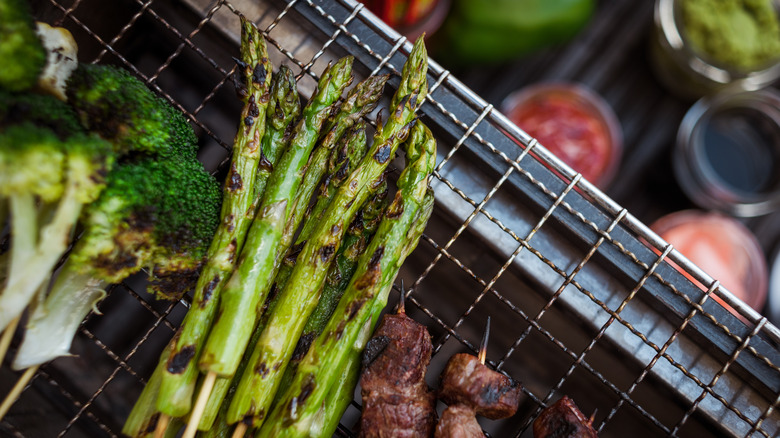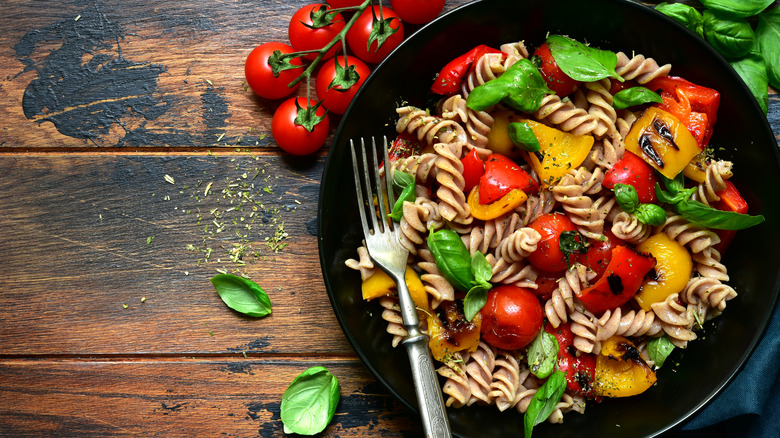Your Chimney Grill Starter Is The Secret To Perfectly Charred Veggies
While it's an ideal summertime tradition, any time you are firing up your charcoal grill is cause for a smile. And although cowboy ribeyes, swordfish steaks, hot dogs, and burgers may be the main focus of many a backyard barbecue, even the most staunch carnivores have been known to get flushed and flirty with a batch of well-charred veggies. The problem is, all too often, those delicate zucchini discs and bell pepper wedges can find themselves wilted, abused, and treated as an afterthought when prepared on a standard charcoal grill. However, the secret to flame-kissed veggies that still keep their bite lies in the very tool used to start the party in the first place — your humble charcoal chimney starter.
The concentrated heat found inside a lit chimney starter is the result of its compact chamber being tightly packed with charcoal. Once those briquettes hit the grill, their ability to maintain high heat dwindles fast, and since the prime real estate on the grates often goes to proteins, veggies tend to end up relegated to cooler, less efficient areas. So, instead of letting veggies slow-roast their way to eternal sogginess on the grill, the trick is to use the charcoal chimney itself as a high-heat cooking vessel in order to quickly achieve a gorgeous char. The focused burst of heat will ensure the outside gets blistered while avoiding wilting.
The method to the madness
Though it makes for an unorthodox cooking method, its simplicity makes the technique achievable for even the most amateur grill sergeant. After lighting your chimney and placing it on your grill, you'll want to wait about 20 minutes until the coals turn a grayish-white and ash over, then grab a wire rack (the kind you might use in the oven to crisp up bacon) lightly oil it and place it directly on top. If you don't have a wire rack handy, a grill basket will work too, as will any flat, food-safe metal tray that allows the flames to make direct contact with the vegetables. Give it a few minutes to heat up, then throw on the veggies of your choice in small batches and flip them as they char, making sure to pull them from the flames while their structural integrity remains intact.
Believe it or not, the charcoal you use can actually make a difference as well. Briquettes are more common and will certainly provide plenty of heat, but lump charcoal burns even hotter. So if you are using lump charcoal, be sure to watch your veggies very carefully as they cook to make sure they don't end up incinerated.
More than a one-trick pony
Charred veggies are a great side dish, as they will complement just about any cut of meat you pull off the grill. A little drizzle of olive oil and some kosher salt and the dish is done. But if you want to have a little more fun with them, it's easy to get creative as well.
Charred asparagus or bell peppers bring a wonderful smoky flavor to any pasta salad, while a few blackened corn kernels sprinkled with a dusting of chili powder will make your fish tacos come alive. And served cold alongside a charcuterie board, a mix of properly blistered veggies immediately elevates the arrangement.
Looking to replace the boring celery stalks that you serve alongside buffalo wings? Charred carrots will make for a better dunk in a homemade blue cheese dressing than you ever would have guessed. But as is the case with most root vegetables, you'll want to parboil them first before charring or else they will end up too tough.
And if you went too far and flat-out burned your veggies instead of charring them, all is not lost either, as you can grind up the burnt-to-ash vegetables and combine them with sea salt to make a tasty umami-tinged seasoning, or mix them up with a soft cheese like brie for a killer spread. With a chimney grill starter, the perfect charred veggies are always within reach.


